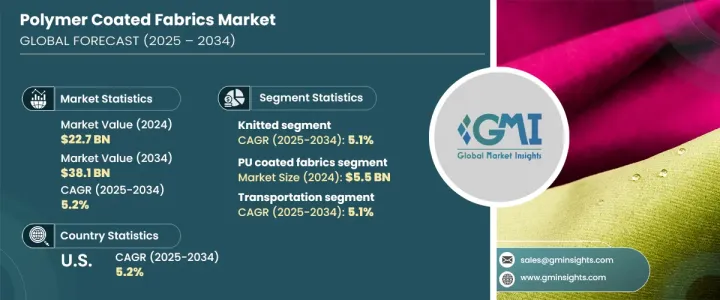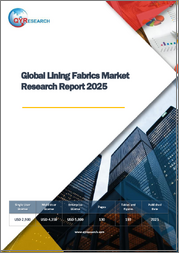
|
시장보고서
상품코드
1685094
폴리머 코팅 패브릭 시장 기회, 성장 촉진 요인, 산업 동향 분석, 예측(2025-2034년)Polymer Coated Fabrics Market Opportunity, Growth Drivers, Industry Trend Analysis, and Forecast 2025 - 2034 |
||||||
폴리머 코팅 패브릭 세계 시장은 2024년에 227억 달러에 달했고, 2025년부터 2034년까지 연평균 복합 성장률(CAGR) 5.2%로 성장할 것으로 예상됩니다.
급속한 산업화, 재료 기술의 진보, 수송, 가구, 항공우주, 건설 등 주요 산업 수요 증가가 이러한 성장을 뒷받침하고 있습니다. 고분자 코팅은 내구성, 내후성, 맞춤화가 뛰어나기 때문에 기업은 고분자 코팅에 많은 투자를 하고 있습니다. 산업계가 고성능 소재를 우선시하는 가운데, 폴리머 코팅 패브릭의 채택은 급증할 것으로 예상됩니다.

시장을 활성화하는 가장 큰 요인 중 하나는 유연하고 가벼운 지속 가능한 소재에 대한 수요 증가입니다. 개발 제조업체 각 사는 혁신적인 폴리머 코팅을 개발해, 환경을 배려하면서 원단의 성능을 높이고 있습니다. 에너지 효율이 뛰어나 재활용 가능한 소재로의 변화가 바이오 베이스나 물 베이스의 코팅제를 자사 제품에 도입하도록 각 사를 뒷받침하고 있습니다. 게다가 전자상거래 분야의 확대는 보호적이고 미적인 포장재 수요를 끌어올려 시장 성장에 더욱 기여하고 있습니다. 안전성, 효율성 및 지속가능성을 중시하는 산업이 증가함에 따라 폴리머 코팅 패브릭은 최신 재료 솔루션에서 중요한 역할을 하고 있습니다.
| 시장 범위 | |
|---|---|
| 시작 연도 | 2024년 |
| 예측 연도 | 2025-2034년 |
| 시작 금액 | 227억 달러 |
| 예측 금액 | 381억 달러 |
| CAGR | 5.2% |
제품 유형별로 볼 때 폴리머 코팅 패브릭 시장은 PE 코팅 직물, 비닐 코팅 직물, PU 코팅 직물 등으로 분류됩니다. PU 코팅 직물 분야는 2024년에 55억 달러를 창출했고 예측 기간 동안 CAGR 5.3%로 성장할 것으로 예측됩니다. PU 코팅은 뛰어난 내구성, 유연성, 통기성에 의해 두드러지며 편안함과 내구성이 필요한 응용 분야에 이상적인 선택입니다. 다른 폴리머 코팅과는 달리, PU는 천연 소재에 가까운 부드럽고 부드러운 질감을 제공하므로 보호복, 고기능 의류, 고급 의자 등에 선호되는 옵션입니다. 자동차 인테리어, 패션, 의료 용도로 PU 코팅 직물의 채용이 증가하고 있는 것이 시장 확대를 더욱 강화하고 있습니다.
섬유 소재유형별로 보면 폴리머 코팅 패브릭 시장은 니트, 직물, 부직포로 구분됩니다. 니트 원단 분야가 시장을 독점하고, 2024년에는 105억 달러를 창출했으며, 예측 기간중의 CAGR은 5.1%를 나타낼 것으로 예측됩니다. 니트 직물은 유연성, 신축성, 적응성이 높게 평가되어 편안함과 움직임이 가장 중요한 산업에서 필수적입니다. 그것의 매끄러운 구조는 촉감의 매력을 높이고 액티브웨어, 자동차 인테리어, 스포츠웨어 수요를 끌어 올리고 있습니다. 지속가능성이 뒷받침됨에 따라 제조업체는 친환경 소재와 생분해성 소재를 니트 원단 생산에 통합하여 시장 성장을 더욱 강화하고 있습니다.
미국의 폴리머 코팅 패브릭 시장의 2024년 시장 규모는 63억 달러로 2025년부터 2034년까지 연평균 복합 성장률(CAGR) 5.2%로 성장할 것으로 예측됩니다. 자동차, 항공우주, 해양, 건설, 헬스케어의 각 분야에서의 용도의 확대가 시장 성장의 주요 요인입니다. 이 패브릭은 가볍고 내구성이 뛰어나고 난연성이기 때문에 내부 용도에 널리 선호됩니다. 에너지 효율적인 소재와 지속가능한 제조방법이 중시됨에 따라 기업은 환경에 배려한 폴리머 코팅의 도입을 강요하고 있습니다. 기술 혁신이 업계를 계속 형성하고 있는 가운데, 미국 시장은 기술의 진보와 소비자 의식의 고조에 힘입어 지속적인 확대가 예상됩니다.
목차
제1장 조사 방법과 조사 범위
- 시장 범위와 정의
- 기본 추정과 계산
- 예측 계산
- 데이터 소스
제2장 주요 요약
제3장 업계 인사이트
- 생태계 분석
- 밸류체인에 영향을 주는 요인
- 이익률 분석
- 혁신
- 장래의 전망
- 제조업체
- 유통업체
- 공급자의 상황
- 이익률 분석
- 주요 뉴스
- 규제 상황
- 영향요인
- 성장 촉진요인
- 자동차 산업 수요 증가
- 보호복에 대한 의식의 고조
- 건설 및 인프라 프로젝트 확대
- 업계의 잠재적 위험 및 과제
- 환경에 대한 우려와 지속가능성의 과제
- 성장 촉진요인
- 성장 가능성 분석
- Porter's Five Forces 분석
- PESTEL 분석
제4장 경쟁 구도
- 소개
- 기업 점유율 분석
- 경쟁 포지셔닝 매트릭스
- 전략 전망 매트릭스
제5장 시장 추정 및 예측 : 제품별, 2021년-2034년
- 주요 동향
- 비닐 코팅 직물
- PU 코팅 직물
- PE 코팅 직물
- 기타
제6장 시장추정 및 예측 : 텍스타일 재료 유형별, 2021-2034년
- 주요 동향
- 니트
- 직물
- 부직포
제7장 시장 추정 및 예측 : 용도별, 2021년-2034년
- 주요 동향
- 수송
- 보호복
- 산업
- 지붕
- 어닝 및 캐노피
- 가구 및 좌석
- 기타
제8장 시장 추정 및 예측 : 지역별, 2021-2034년
- 주요 동향
- 북미
- 미국
- 캐나다
- 유럽
- 영국
- 독일
- 프랑스
- 이탈리아
- 스페인
- 러시아
- 아시아태평양
- 중국
- 인도
- 일본
- 한국
- 호주
- 라틴아메리카
- 브라질
- 멕시코
- 중동 및 아프리카
- 남아프리카
- 사우디아라비아
- 아랍에미리트(UAE)
제9장 기업 프로파일
- BASF
- Covestro
- Dow
- DuPont
- Eastman
- Evonik
- Huntsman
- Solvay
The Global Polymer Coated Fabrics Market reached USD 22.7 billion in 2024 and is set to expand at a CAGR of 5.2% between 2025 and 2034. Rapid industrialization, advancements in material technology, and increasing demand across key industries, including transportation, furniture, aerospace, and construction, are driving this growth. Companies are investing heavily in polymer coatings due to their superior durability, weather resistance, and customization capabilities. As industries continue to prioritize high-performance materials, the adoption of polymer-coated fabrics is expected to surge.

One of the most significant factors fueling the market is the rising demand for flexible, lightweight, and sustainable materials. Manufacturers are developing innovative polymer coatings to enhance fabric performance while ensuring eco-friendliness. The shift towards energy-efficient and recyclable materials is pushing companies to integrate bio-based and water-based coatings into their offerings. Additionally, the expansion of the e-commerce sector has bolstered the demand for protective and aesthetic packaging materials, further contributing to market growth. With an increasing number of industries emphasizing safety, efficiency, and sustainability, polymer-coated fabrics are playing a crucial role in modern material solutions.
| Market Scope | |
|---|---|
| Start Year | 2024 |
| Forecast Year | 2025-2034 |
| Start Value | $22.7 Billion |
| Forecast Value | $38.1 Billion |
| CAGR | 5.2% |
Based on product type, the polymer coated fabrics market is categorized into PE-coated fabrics, vinyl-coated fabrics, PU-coated fabrics, and others. The PU-coated fabrics segment generated USD 5.5 billion in 2024 and is projected to grow at a CAGR of 5.3% during the forecast period. PU coatings stand out due to their exceptional endurance, flexibility, and breathability, making them an ideal choice for applications requiring comfort and durability. Unlike other polymer coatings, PU offers a soft and smooth texture that closely resembles natural materials, making it a preferred option for protective clothing, high-performance apparel, and premium upholstery. The increasing adoption of PU-coated fabrics in automotive interiors, fashion, and medical applications is further strengthening market expansion.
By textile material type, the polymer coated fabrics market is segmented into knitted, woven, and non-woven fabrics. The knitted fabrics segment dominated the market, generating USD 10.5 billion in 2024, and is anticipated to grow at a CAGR of 5.1% during the forecast period. Knitted fabrics are highly valued for their flexibility, stretchability, and adaptability, making them essential in industries where comfort and movement are paramount. Their seamless construction enhances the tactile appeal, boosting demand in activewear, automotive interiors, and sportswear. As sustainability gains traction, manufacturers are incorporating eco-friendly and biodegradable materials into knitted fabric production, further propelling market growth.
The U.S. polymer coated fabrics market was valued at USD 6.3 billion in 2024 and is forecast to grow at a CAGR of 5.2% from 2025 to 2034. The expanding application base across automotive, aerospace, marine, construction, and healthcare sectors is a primary driver of market growth. These fabrics are widely preferred for interior applications due to their lightweight nature, durability, and flame-retardant properties. The growing emphasis on energy-efficient materials and sustainable manufacturing practices is compelling companies to introduce eco-conscious polymer coatings. As innovation continues to shape the industry, the U.S. market is expected to witness sustained expansion, backed by technological advancements and increasing consumer awareness.
Table of Contents
Chapter 1 Methodology & Scope
- 1.1 Market scope & definitions
- 1.2 Base estimates & calculations
- 1.3 Forecast calculations
- 1.4 Data sources
- 1.4.1 Primary
- 1.4.2 Secondary
- 1.4.2.1 Paid sources
- 1.4.2.2 Public sources
Chapter 2 Executive Summary
- 2.1 Industry synopsis, 2021-2034
Chapter 3 Industry Insights
- 3.1 Industry ecosystem analysis
- 3.1.1 Factor affecting the value chain
- 3.1.2 Profit margin analysis
- 3.1.3 Disruptions
- 3.1.4 Future outlook
- 3.1.5 Manufacturers
- 3.1.6 Distributors
- 3.2 Supplier landscape
- 3.3 Profit margin analysis
- 3.4 Key news & initiatives
- 3.5 Regulatory landscape
- 3.6 Impact forces
- 3.6.1 Growth drivers
- 3.6.1.1 Increasing demand in automotive sector
- 3.6.1.2 Rising awareness of protective clothing
- 3.6.1.3 Expanding construction and infrastructure projects
- 3.6.2 Industry pitfalls & challenges
- 3.6.2.1 Environmental concerns and sustainability challenges
- 3.6.1 Growth drivers
- 3.7 Growth potential analysis
- 3.8 Porter’s analysis
- 3.9 PESTEL analysis
Chapter 4 Competitive Landscape, 2024
- 4.1 Introduction
- 4.2 Company market share analysis
- 4.3 Competitive positioning matrix
- 4.4 Strategic outlook matrix
Chapter 5 Market Estimates & Forecast, By Product, 2021-2034 (USD Million) (Tons)
- 5.1 Key trends
- 5.2 Vinyl coated fabrics
- 5.3 PU coated fabrics
- 5.4 PE coated fabrics
- 5.5 Others
Chapter 6 Market Estimates & Forecast, By Textile Material Type, 2021-2034 (USD Million) (Tons)
- 6.1 Key trends
- 6.2 Knitted
- 6.3 Woven
- 6.4 Non-woven
Chapter 7 Market Estimates & Forecast, By Application, 2021-2034 (USD Million) (Tons)
- 7.1 Key trends
- 7.2 Transportation
- 7.3 Protective clothing
- 7.4 Industrial
- 7.5 Roofing
- 7.6 Awnings & canopies
- 7.7 Furniture & seating
- 7.8 Others
Chapter 8 Market Estimates & Forecast, By Region, 2021-2034 (USD Million) (Tons)
- 8.1 Key trends
- 8.2 North America
- 8.2.1 U.S.
- 8.2.2 Canada
- 8.3 Europe
- 8.3.1 UK
- 8.3.2 Germany
- 8.3.3 France
- 8.3.4 Italy
- 8.3.5 Spain
- 8.3.6 Russia
- 8.4 Asia Pacific
- 8.4.1 China
- 8.4.2 India
- 8.4.3 Japan
- 8.4.4 South Korea
- 8.4.5 Australia
- 8.5 Latin America
- 8.5.1 Brazil
- 8.5.2 Mexico
- 8.6 MEA
- 8.6.1 South Africa
- 8.6.2 Saudi Arabia
- 8.6.3 UAE
Chapter 9 Company Profiles
- 9.1 BASF
- 9.2 Covestro
- 9.3 Dow
- 9.4 DuPont
- 9.5 Eastman
- 9.6 Evonik
- 9.7 Huntsman
- 9.8 Solvay



















